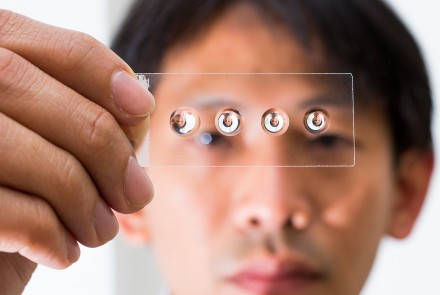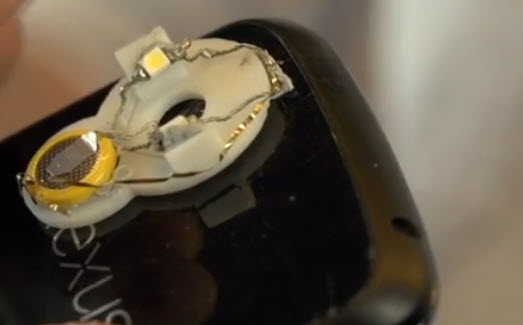Droplet lens turns a smartphone into a 160X microscope
May 1, 2014
Australian scientists have invented a simple and cheap way of making a high-powered lens that can transform a smart phone into a high-resolution microscope.
Costing less than a cent, the lenses promise a revolution in science and medicine in developing countries and remote areas.
Self-forming liquid drops
The lens fabrication technique was invented by Steve Lee from The Australian National University (ANU) Research School of Engineering. “We put a droplet of polymer onto a microscope cover slip and then invert it. Then we let gravity do the work, to pull it into the perfect curvature,” Lee said.
“By successively adding small amounts of fluid to the droplet, we discovered that we can reach a magnifying power of up to 160 times with an imaging resolution of four micrometers.”
The polymer, polydimethylsiloxane (PDMS), is the same as that used for contact lenses, and it won’t break or scratch. “It would be perfect for the third world. All you need is a fine tipped tool, a cover slip, some polymer and an oven,” Lee said.
Lee and his team worked with Tri Phan from Sydney’s Garvan Institute of Medical Research to find ways to transform the lens into a medical imaging tool. They designed a lightweight 3D-printable frame to hold the lens, along with a couple of miniature LED lights for illumination, and a coin battery.
Phan said the tiny microscope has a wide range of potential uses, particularly if coupled with the right smartphone apps. “This is a whole new era of miniaturization and portability – image analysis software could instantly transform most smartphones into sophisticated mobile laboratories,” Dr Phan said.
Lee said the low-cost lens had already attracted interest from a German group interested in using disposable lenses for tele-dermatology. “There are also possibilities for farmers,” he said. “They can photograph fungus or insects on their crops, upload the pictures to the internet where a specialist can identify if they are a problem or not.”
The lens-making technology is described in Biomedical Optics Express (open access), published by The Optical Society.
An Australian National University scientist has discovered a simple, cheap way of turning a smart phone into a high-resolution microscope, opening the door to a revolution in science and medicine in developing countries.>/em>
Abstract of Biomedical Optics Express paper
Existing methods for low cost lenses using parallel mold stamping and high temperature reflow requires complex engineering controls to produce high quality lenses. These manufacturing techniques rely on expensive equipment. In this paper, we propose a low cost (< $ 0.01 per pc) flexible moldless lens fabrication method based on curing a hanging transparent polydimethylsiloxane (PDMS) elastomer droplet on a curved substrate. Additional deposition of hanging droplets in the same manner led to a substantial increase in the lens curvature and concomitant decrease in the focal length of the PDMS lenses down to ~2 mm. The shortest focal length lenses were shown to collimate light from a bare light emitting diode (LED) and image microscopic structures down to around 4 µm with 160x magnification. Our hanging droplet lens fabrication technique heralds a new paradigm in the manufacture of low cost, high performance optical lenses for the masses. Using these lenses, we were able to transform an ordinary commercial smartphone camera into a low-cost digital dermascope (60x magnification) that can readily visualize microscopic structures on skin such as sweat pores.

